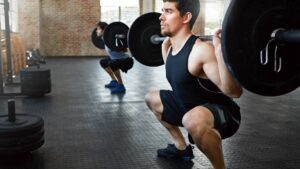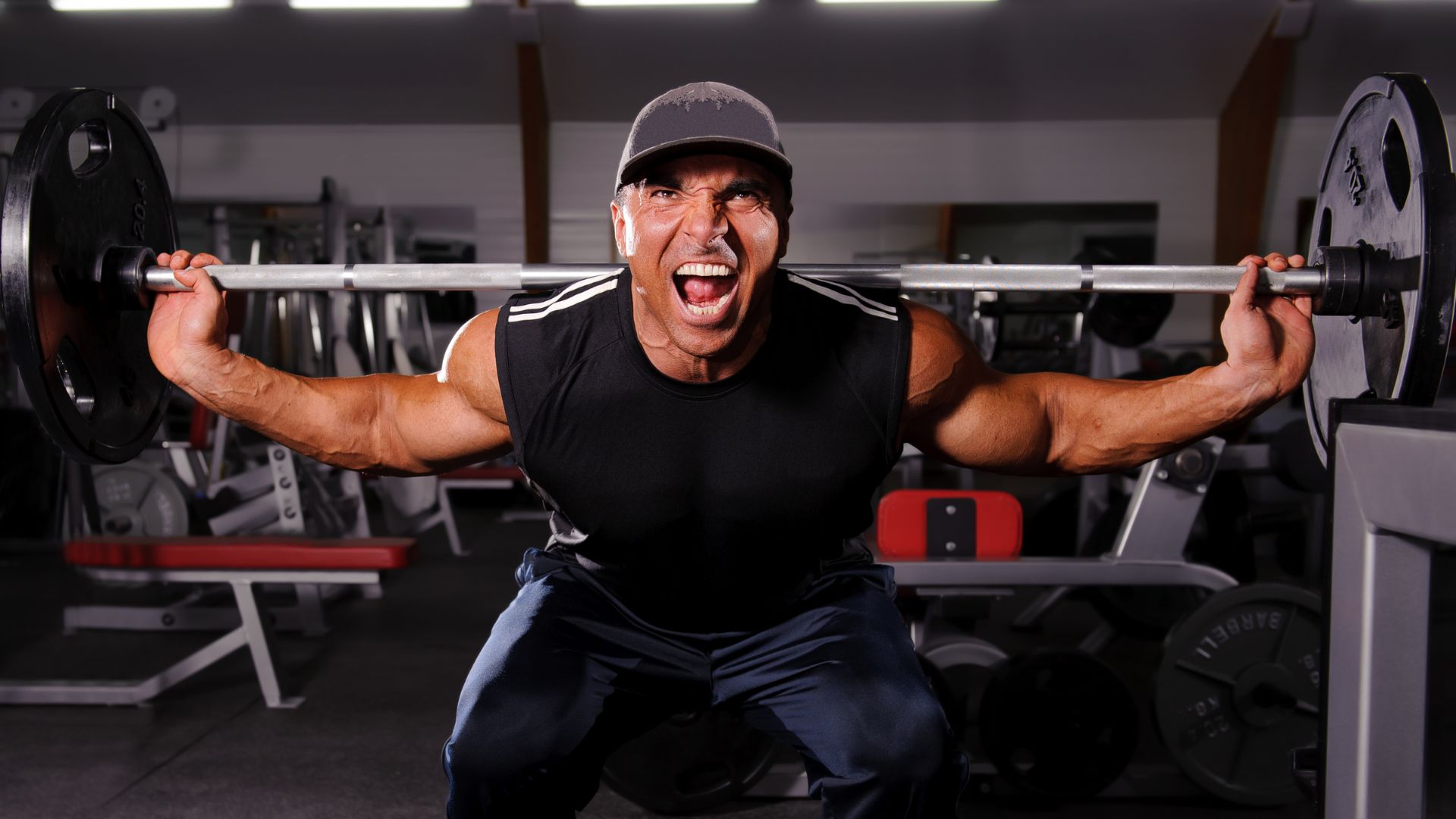Ever wondered if that loud yell as you descend into a squat with a barbell is doing you any good? You’re not alone! Yelling during weightlifting has become a topic of debate in gyms worldwide.
In this blog post, we’re going to dive into the science and etiquette behind yelling during squats, helping you understand whether it’s a beneficial boost or a potential bust for your workout routine. Let’s settle this with some solid facts and practical advice.
Understanding whether or not Yelling While Squatting with a Barbell is a Bad Idea.
Yes, yelling when you go down in a squat with a barbell can be counterproductive and potentially harmful in several ways.
Let’s break down why it’s not recommended:
Loss of Breath Control: Yelling loudly during a squat can disrupt your breath control.
Proper breathing is essential for maintaining stability and core engagement during the lift.
Yelling can cause you to exhale forcefully, which might make it difficult to maintain proper intra-abdominal pressure.
Loss of Focus: Yelling can distract you from maintaining proper form and technique during the squat.
Squatting with proper form is crucial for preventing injuries and maximizing the effectiveness of the exercise.
Safety Concerns: If you are lifting heavy weights, yelling could potentially affect your balance and stability.
This could lead to an increased risk of accidents or injuries, such as losing your balance and dropping the barbell.
Social Considerations: Yelling loudly in a gym can be disruptive to others and may not be appreciated by fellow gym-goers or gym staff.
It’s important to maintain a respectful and considerate environment in a gym.

Instead of yelling, consider the following:
Focus on Controlled Breathing: Practice controlled breathing techniques, such as the Valsalva maneuver, which involves taking a deep breath and bracing your core before descending into the squat. This helps maintain stability and protect your spine.
Use Proper Form: Concentrate on maintaining proper squatting technique throughout the movement. This includes keeping your back straight, chest up, knees tracking over your toes, and hips back.
Lift with Control: Lower the barbell under control, maintaining tension in your muscles, and then drive back up explosively if that’s your lifting style. Y
elling is not necessary to exert effort during the lift.
Stay Focused: Keep your mind on the lift and your form.
Avoid distractions that could compromise your safety or effectiveness in the exercise.
In other words, yelling during a squat with a barbell is generally not recommended.
Focus on maintaining proper form, controlled breathing, and safe lifting practices to maximize the benefits of the exercise while minimizing the risk of injury.
Further Explanations.
Let’s dive deeper and elaborate further on all the points mentioned.
let’s delve deeper into why yelling during a squat can lead to a loss of breath control and focus:
Loss of Breath Control.
Breath Control Importance:
Proper breathing during strength exercises like squats is essential because it helps stabilize your spine and core. This is crucial for maintaining a safe and effective lifting posture.
Intra-abdominal Pressure:
When you take a deep breath and brace your core before performing a squat, you increase intra-abdominal pressure.
This pressure acts like a natural weightlifting belt, supporting your spine and preventing it from collapsing under the load of the barbell.
Yelling and Forceful Exhalation:
Yelling involves forcefully expelling air from your lungs. This abrupt exhalation can disrupt the controlled breathing pattern necessary for maintaining the desired intra-abdominal pressure.
When this pressure is compromised, it can increase the risk of spinal injury and reduce your overall strength and stability during the lift.
Loss of Focus:
Concentration on Form:
Proper squat form requires a high degree of focus. You need to ensure that your back remains straight, your chest is up, your knees track over your toes, and your hips are pushed back as you descend and ascend. Any distraction from this form can lead to poor technique.
Yelling as a Distraction:
Yelling loudly can be a distracting action in itself. When you make a loud noise, your focus shifts from the exercise’s technical aspects to the act of yelling.
This diversion of attention from your form and technique can result in mistakes, such as rounding your back or allowing your knees to cave in, which can lead to injuries.
In essense, maintaining breath control and focus is essential for safe and effective squatting with a barbell.
Yelling disrupts these crucial components because it involves forceful exhalation and diverts your attention from maintaining proper form.
To optimize your squat performance and reduce the risk of injury, it’s advisable to concentrate on controlled breathing and precise technique rather than yelling during the exercise.
let’s delve into the safety concerns and social considerations associated with yelling while squatting with a barbell:
Safety Concerns.
Balance and Stability:
When lifting heavy weights, maintaining balance and stability is critical. Yelling loudly during a squat can disrupt your focus and concentration, potentially causing you to lose your balance.
This loss of balance could lead to accidents or injuries, such as falling forward or backward while under the load of the barbell.
In extreme cases, it might even result in the barbell dropping, posing a serious risk to your safety and that of others in the gym.
Muscular Control:
Yelling can cause sudden and unexpected muscular contractions, particularly in your upper body and neck.

These contractions can interfere with the controlled movement required during a squat.
For example, a sudden contraction in your neck muscles might cause you to jerk your head or upper body, leading to a breakdown in form and potentially risking injury.
Social Considerations.
Disruption to Others:
Gyms are shared spaces where many people come to work out and focus on their fitness goals.
Yelling loudly during exercises can be disruptive and distracting to other gym-goers. It can disrupt their concentration and potentially make their workout experience less enjoyable or effective.
Gym Etiquette:
Many gyms have established rules and etiquette guidelines to ensure a respectful and harmonious environment.
Yelling loudly may violate these guidelines and be seen as inconsiderate behavior. Gym staff and fellow members may not appreciate this disruption and could even lead to complaints or confrontations.
Safety of Others:
In addition to disrupting others, yelling can create an environment of unpredictability and tension in the gym.
This can be concerning for those around you, especially when lifting heavy weights. Others might worry about the potential for accidents or unexpected behavior, which can negatively impact their gym experience.
In all this if that, yelling while squatting with a barbell can have safety implications for both yourself and others. It can lead to balance and stability issues, increasing the risk of accidents or injuries.
Moreover, it can disrupt the gym environment and violate established etiquette, potentially causing discomfort or conflicts with fellow gym-goers and staff.
To maintain a safe and respectful gym atmosphere, it’s advisable to focus on controlled breathing, proper form, and considerate behavior while lifting weights.
Do this Instead of yelling:
let’s go into more detail about the importance of controlled breathing and proper form during a squat with a barbell:
1. Focus on Controlled Breathing (Valsalva Maneuver).
Controlled breathing techniques, like the Valsalva maneuver, are essential during heavy compound lifts like squats.
Here’s how it works:
Deep Breath:
Before you start the squat, take a deep breath in through your nose.
This breath should fill your diaphragm and expand your chest and abdomen. This is known as a “belly breath.”
Bracing Your Core:
After taking that deep breath, brace your core muscles. Imagine someone is about to punch you in the stomach, and you need to tense up to protect yourself.
This action increases intra-abdominal pressure, stabilizing your spine.
Descend into the Squat:
As you begin to descend into the squat, you should maintain this braced core and held breath.
The pressure you’ve built up inside your abdomen acts like a natural weightlifting belt, supporting your spine and preventing it from collapsing under the weight of the barbell.
Exhale at the Top:
Once you’ve completed the squat and are back at the top position, you can exhale and take another breath before your next repetition.
2. Use Proper Form.
Maintaining proper squat form is crucial to prevent injuries and maximize the effectiveness of the exercise. Here’s a breakdown of the key aspects of proper squat form:
Back Straight:
Keep your back straight throughout the entire squat movement. Avoid rounding or arching your back, as this can put excessive strain on your spine.
Chest Up:
Your chest should be up and facing forward. This helps maintain a neutral spine position and prevents you from leaning too far forward.
Knees Tracking Over Toes:
Your knees should align with your toes as you descend into the squat.
They should not cave inward or push too far forward beyond your toes. Proper alignment helps protect your knee joints.
Hips Back:
Initiate the squat by pushing your hips back and then bending your knees. This movement pattern engages your glutes and hamstrings while minimizing stress on your knees.
Depth:
Aim to squat to at least parallel or below parallel, where your thighs are parallel to the ground or lower. Going deep enough ensures you engage your leg muscles fully and get the most out of the exercise.
Steady Descent and Ascent:
Lower the barbell under control and maintain a steady pace throughout the squat. Avoid rapid or jerky movements that can lead to loss of balance or poor form.
In other words, controlled breathing through the Valsalva maneuver helps stabilize your spine and protect it during the squat.
Proper form, including maintaining a straight back, chest up, knees over toes, and pushing your hips back, ensures you perform the exercise safely and effectively.
By focusing on these elements, you can optimize your squatting technique and reduce the risk of injury.
Let’s explore the importance of lifting with control and staying focused during a barbell squat:
3. Lift with Control.
Lower the Barbell Under Control:
When you lower the barbell under control, you are emphasizing the eccentric phase of the lift. This is the part of the squat where you are descending.
Lowering the barbell with control allows you to maintain proper form and balance throughout the movement.
It reduces the risk of sudden shifts in weight that could compromise your stability.
Maintain Tension in Your Muscles:
Keeping your muscles engaged and tense throughout the squat is crucial for maintaining stability and control.
This tension helps support your joints and spine, reducing the risk of injury. It also ensures that you’re using your muscles effectively to perform the lift.
Drive Back Up Explosively (If Applicable):
The concentric phase of the squat, where you’re pushing the barbell back up, can be executed explosively if that’s your lifting style. Explosive power is often used in powerlifting and athletic training.
However, even in explosive lifting, control is essential during the eccentric phase to set up for a powerful ascent.
Yelling is not necessary to exert effort during this phase. Controlled breathing and focused effort are more effective ways to generate force.
4. Stay Focused:
Mind on the Lift:
During a heavy squat, your attention should be fully on the lift itself. This focus allows you to maintain proper form, track your breathing, and be aware of your body’s position throughout the movement.
Avoid Distractions:
Distractions in the gym, such as talking to others, looking at your phone, or even loud noises like yelling, can divert your attention.
Any lapse in focus can compromise your safety and effectiveness during the exercise. It’s crucial to create a mental environment where you are fully engaged with the task at hand.
Safety and Effectiveness:
Maintaining focus ensures that you are aware of your body’s mechanics and any signs of fatigue or discomfort. It also helps prevent errors in form that can lead to injury.
Staying focused is a key aspect of safe and effective strength training.
In summary, lifting with control and staying focused are essential components of a successful barbell squat:
Controlled lowering and raising of the barbell maintains stability and muscle engagement.
Keeping your mind on the lift and avoiding distractions is crucial for safe and effective squatting.
Yelling is not necessary to exert effort during the lift; instead, focus on controlled breathing, form, and maintaining tension in your muscles to optimize your squat performance.
A tabular on this topic here.
Here’s a tabular breakdown of the key points regarding whether yelling when going down in a squat with a barbell is bad:
| Aspect | Yelling When Squatting with a Barbell |
|---|---|
| Impact on Breath Control | Disrupts proper breathing and can lead to a loss of intra-abdominal pressure, which is essential for stability. |
| Loss of Focus | Can distract from maintaining proper form and technique during the squat, potentially leading to poor execution and increased injury risk. |
| Safety Concerns | May affect balance and stability, increasing the risk of accidents, falls, or dropping the barbell, especially when lifting heavy weights. |
| Social Considerations | Yelling loudly in a gym can be disruptive to others, violate gym etiquette, and create an uncomfortable environment for fellow gym-goers. |
| Effect on Muscle Control | Yelling can cause sudden muscular contractions, which may interfere with controlled movement and proper muscle engagement. |
| Distraction from Concentration | Diverts attention from the task at hand, making it challenging to maintain focus and perform the squat with precision and control. |
| Effort Exertion During the Lift | Yelling is not necessary to exert effort during the lift; controlled breathing, form, and muscle engagement are more effective methods. |
In summary, yelling during a barbell squat is generally discouraged due to its negative impacts on breath control, focus, safety, social considerations, muscle control, concentration, and the effectiveness of effort exertion during the lift.
Conclusion.
In conclusion, yelling during a barbell squat is not advisable as it can disrupt breath control, lead to a loss of focus, pose safety risks, create social discomfort, interfere with muscle control, distract from concentration, and is unnecessary for exerting effort during the lift.

Hey there, it’s Mike Rrsq, the Editor-in-Chief over at Jsquat.com, and I’m absolutely obsessed with all things squat fitness! I’ve been lucky enough to get some serious recognition for my work in this field. With a solid background in the fitness and wellness industry, I’ve been there right from the get-go, helping shape this website into what it is today.
You see, I’m not just the boss around here; I’m also a passionate contributor. I love sharing my insights through my articles, and trust me, they’re not your run-of-the-mill stuff. Each piece I write is a labor of love, filled with my expertise and real-world experience in the fitness universe. So, if you’re into fitness and looking for some inspiration, you’re in the right place!

